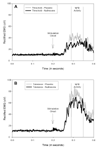Nociceptive flexion reflex and pain rating responses during endogenous opiate blockade with naltrexone in healthy young adults
- PMID: 17244518
- PMCID: PMC1892310
- DOI: 10.1016/j.biopsycho.2006.12.005
Nociceptive flexion reflex and pain rating responses during endogenous opiate blockade with naltrexone in healthy young adults
Abstract
The effect of opioid blockade on nociceptive flexion reflex (NFR) activity and subjective pain ratings was examined in 151 healthy young men and women. Using a within-subjects design, NFR threshold was assessed on 2 days after administration of either placebo or a 50mg dose of naltrexone. Electrocutaneous pain threshold and tolerance levels were measured after NFR threshold assessment on each day. Results indicated that administration of naltrexone was consistently associated with hypoalgesic responding. Specifically, participants exhibited lower levels of NFR activity and reported lower pain ratings for electrocutaneous stimulation delivered at pain threshold and tolerance levels following administration of naltrexone as compared to placebo. These findings indicate that opiate blockade using the current standard dose may elicit hypoalgesia. A potential moderating effect of dose of opiate-blockade medication and level of endogenous opioid activation should be carefully examined in future research.
Figures
References
-
- al'Absi M, Wittmers LE, Ellestad D, Nordehn G, Kim SW, Kirschbaum C, Grant JE. Sex differences in pain and hypothalamic-pituitary-adrenocortical responses to opioid blockade. Psychosomatic Medicine. 2004;66(2):198–206. - PubMed
-
- Bell JA, Martin WR. The effect of the narcotic antagonists naloxone, naltrexone and nalorphine on spinal cord C-fiber reflexes evoked by electrical stimulation or radiant heat. Eur J Pharmacol. 1977;42(2):147–154. - PubMed
-
- Bianchi M, Panerai AE. Naloxone-induced analgesia: involvement of kappa-opiate receptors. Pharmacol Biochem Behav. 1993;46(1):145–148. - PubMed
-
- Bromm B, Meier W, Scharein E. Antagonism between tilidine and naloxone on cerebral potentials and pain ratings in man. Eur J Pharmacol. 1983;87(4):431–439. - PubMed
-
- Bruehl S, Chung OY. Parental history of chronic pain may be associated with impairments in endogenous opioid analgesic systems. Pain. 2006;124(3):287–294. - PubMed
Publication types
MeSH terms
Substances
Grants and funding
LinkOut - more resources
Full Text Sources


